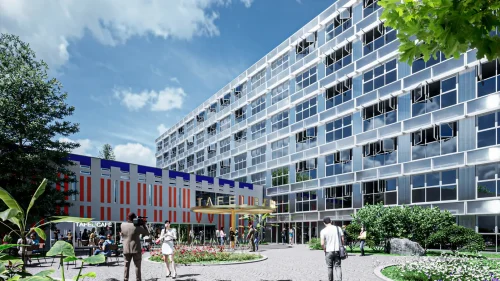Incarceration is often framed as a significant financial burden on society, with discussions frequently focusing on its immediate costs — such as daily expenses for housing people in detention. However, this perspective risks missing the larger picture: the societal and economic consequences of detention and the potential for meaningful justice reform. A holistic approach to justice emphasises investing in people, not just systems, recognising that the true costs of incarceration extend far beyond budgets and balance sheets. By adopting solutions like detention houses, society can reduce long-term economic burdens while fostering more inclusive and safer communities.
This article explores how detention houses can offer substantial long-term advantages that extend beyond mere cost calculations. It underscores that this shift from large prison institutions to detention houses is about more than rethinking detention—it’s about investing in people and breaking harmful cycles.
The funding paradox: investing in ‘security’ hinders reintegration
A comparative analysis of prison expenditures in 54 countries — by Penal Reform International — highlighted that while there are exceptions, overall funding for prisons remains inadequate in several countries. Typically, penitentiary budgets are less than 0.3% of a country’s gross domestic product (GDP). For example, in 2017, average prison spending among EU Member States was only 0.2% of their national GDP. This chronic underinvestment leaves prisons struggling to provide basic needs such as nutrition, healthcare, clothing and safe, hygienic living conditions. It also reflects broader political neglect, as prisons are often seen as a low priority in government budgets.
The allocation of these limited resources raises serious concerns about their effectiveness in supporting individuals towards their release. For example, staffing costs consume the majority of prison budgets, yet high turnover and poor working conditions lead to dissatisfaction and ultimately staff shortages. Ageing infrastructure compounds these challenges, failing to meet contemporary standards and requiring considerable (and expensive) renovations to do so. In addition, a significant portion of funding is directed toward security, frequently prioritising high-security measures that can hinder reintegration efforts.
While the legal mandate emphasises reducing recidivism, the current funding approach often undermines this goal by prioritising an appearance of safety over long-term benefits. Resources must be reallocated to address the root causes of criminal behaviour and, if directed toward detention, should invest in an environment appropriate to address these challenges. Transitioning to smaller, community-integrated facilities would better align resources with the goal of successful reintegration, benefiting both incarcerated individuals and staff.
The (hidden) costs of incarceration
Large prison institutions come with significant hidden costs that — yes — affect the state budget, but also families, communities and future generations. Direct expenses, such as housing individuals in detention, represent only a fraction of the overall economic impact. In Belgium, for example, the daily cost to detain one person was approximately €152.44 in (2022) [1]. Spending on personnel accounted for the largest share (77.53%), followed by operational costs (8.76%), care for the medical and psychological needs of individuals (7.79%), maintenance and food for incarcerated people (3.41%) and infrastructure contracts (2.51%). For comparison, the Netherlands reported a significantly higher figure of €339 (2023) [2] and Portugal €56.33 (2022).
However, these figures exclude indirect costs, such as reoffending, lost productivity, prevention and the increased demands on social and health services. For instance, a study in the UK has estimated the annual economic and social cost of adult reoffending at £16.7 billion. This figure is based on data from people released from prison, identified in 2016, who reoffended within a subsequent 12-month follow-up period. Notably, any reoffending that occurred beyond this one-year timeframe is excluded from this estimate, meaning the actual long-term costs could be even higher. In Norway, the total economic cost of crime, including public resources for prevention, private costs for risk reduction, and productivity losses, is estimated at 144 billion NOK (€12.1 billion) annually – offering a broader perspective on how much incarceration costs society.
In addition to financial costs, incarceration also imposes significant social costs that cut through families and communities. When someone is incarcerated, their family often faces financial hardship and emotional distress. Children of incarcerated parents are particularly vulnerable, as they are more likely to experience poverty, mental health challenges and possible involvement in criminal activity. These negative effects ripple outwards, placing an additional burden on social services, schools, and health care systems.
By considering both the financial and social costs of incarceration, we gain a clearer understanding of its broader implications and the potential advantages of alternatives like detention houses.
How detention houses foster social and economic value
Detention houses signify a pivotal shift in how we approach incarceration. These facilities, strategically embedded within communities, prioritise access to health services, education, employment, and cultural opportunities, fostering continuity and connection post-release.
Unlike large prison institutions, detention houses emphasise building supportive relationships among residents, staff and local stakeholders, fostering a collaborative ecosystem. This ecosystem includes the relationships among incarcerated individuals, staff, visitors, and local service providers, all of which shape the social environment surrounding the detention house. Moreover, detention houses function within a broader context that extends beyond their physical boundaries and the criminal justice system. They exist at the junction of other ecosystems: that of the criminal justice system, the health care and mental health care system, the education system, the employment system etc. and the power structures and social inequalities present in these systems.
A compelling example can be found in Leuven, Belgium, where the recent opening of a third transition house showcases how partnerships between municipalities, justice systems, and NGOs can tackle the complex challenges of reintegration. Initiated by the municipality’s social affairs department in collaboration with the local NGO De Kansenfabriek, this facility was established to address a critical gap in local social services. The department had identified that existing services were under immense strain, struggling to meet the needs of the community while also supporting individuals transitioning out of prison. Recognising the potential benefits of a transition house, they took the initiative to explore the practical options, aiming to improve reintegration outcomes for released individuals while easing pressure on social service staff and safeguarding the quality of support for other citizens. This proactive approach not only enhances community welfare but also demonstrates how detention houses can operate within a broader ecosystem, addressing both individual and collective needs.
The silo structure within governments, where each ministry or department operates with its own budget and policies, often prevents a holistic view such as the example above, highlighting how investments in one sector (such as education or health care) can reduce costs in other sectors (such as the justice system). In March 2024, for example, Portugal’s Interministerial Working Group on Health in places where people are deprived of their liberty recommended that responsibilities for health care in prisons be transferred from the Ministry of Justice to the Ministry of Health. This would integrate health care in prisons into the National Health Service. Studies also underline this need for the broader impact of such ecosystems. The World Health Organization reports that many individuals entering prison have untreated health conditions, and inadequate care exacerbates these issues, leading to higher public health costs once they are released.
By embracing this ecosystem perspective, we can see that supporting individuals in detention leads to significant savings in healthcare and other services, as successful reintegration minimizes the need for costly interventions. This perspective underscores that the benefits of detention houses go beyond criminal justice costs; they represent an investment in people and a pathway to long-term savings for society.
Conclusion: A smart investment in society
While it may seem cost-effective to cut spending on incarceration and rehabilitation, this short-term thinking overlooks the long-term societal costs. True savings come not from cutting corners, but from making smart investments in the future of incarcerated individuals. By helping them re-enter into society as healthy, productive citizens, we can reduce the overall economic burden of crime, improve public health, and foster stronger, safer communities.
Detention houses embody this approach, offering a vision of justice that prioritises humanity and sustainability. Society must recognize that the daily cost per incarcerated person per day is only a small part of the overall equation. By adopting a holistic view that accounts for both economic and social impacts, we can make more informed decisions and build a justice system that benefits everyone. This includes breaking down silo’s and doing politics from a long-term perspective!
Investing in people is ultimately an investment in the future of society.


This article was written as part of the Erasmus+ funded INSPIRE-project. Views and opinions expressed are however those of the author(s) only and do not necessarily reflect those of the European Union or the European Education and Culture Executive Agency (EACEA). Neither the European Union nor EACEA can be held responsible for them.
REFERENCES AND FURTHER READING:
[1] The actual daily cost per prisoner was €148.73 in 2021 and €152.44 in 2022 (excluding forensic psychiatric centres and transition houses).
[2] In the Netherlands, the average cost per incarcerated person in a standard prison is around €339 per day. In more specialized facilities, such as penitentiary psychiatric centres (PPC), this cost can rise to €583 per day.
Aebi, M. F., & Cocco, E. (2024). SPACE I — 2023 – Council of Europe Annual Penal Statistics: Prison populations. Council of Europe.
Comfort, M., McKay, T., Landwehr, J., Kennedy, E., Lindquist, C., & Bir, A. (2016). The costs of incarceration for families of prisoners. International Review of the Red Cross, 98(903), 783–798.
De Kamer van Volksvertegenwoordigers — Schriftelijke vraag en antwoord nr 55-1668: Dagelijkse kostprijs gedetineerden gevangenis. (2023, April 25). De Kamer van Volksvertegenwoordigers. Retrieved from www.lachambre.be
Dienst Justitiële Inrichtingen. (2024). Infographic Gevangeniswezen 2024. In Dienst Justitiële Inrichtingen. Retrieved November 14, 2024, from https://www.dji.nl/binaries/dji/documenten/publicaties/2023/05/30/infographic-gevangeniswezen/Infographic+gevangeniswezen.pdf
Dgrsp. (2024, April 1). Apresentado o Plano de saúde para as prisões. justiça.gov.pt. Retrieved November 20, 2024, from https://justica.gov.pt/Noticias/Apresentado-o-Plano-de-saude-para-as-prisoes
“Imprisonment is expensive” — Breaking down the costs and impacts globally — Penal Reform International. (2020, August 5). Penal Reform International. Retrieved November 14, 2024, from https://www.penalreform.org/blog/imprisonment-is-expensive-breaking-down-the-costs-and/
Newton, A., May, X., Eames, S., Ahmad, M., & Ministry of Justice. (2019). Economic and social costs of reoffending: Analytical report (ISBN 978-1-84099-887-0). Ministry of Justice. Retrieved November 14, 2024, from https://assets.publishing.service.gov.uk/media/5d1de7a4e5274a08d13a684e/economic-social-costs-reoffending.pdf
Novais, J. [Coordinator]. (2022, March 14). Estudo de viabilidade económica e financeira. Centro de Estudos de Gestão e Economia Aplicada, Católica Porto. Prepared for Reshape Portugal. Retrieved November 14, 2024, from https://reshape.org/wp-content/uploads/2023/10/RESHAPE_Estudo-viabilidade-economica-e-financeira.pdf
Oslo Economics. (2023). Samfunnsøkonomiske gevinster av redusert tilbakefall til kriminalitet. Retrieved November 14, 2024, from https://www.rodekors.no/globalassets/_rapporter/humanitar-analyse-rapporter/samfunnsokonomiske-gevinster-av-redusert-tilbakefall-til-kriminalitet.pdf
World Health Organization — Regional Office for Europe. (2019). Health in prisons: Fact sheets for 38 European countries. WHO Regional Office for Europe. Retrieved November 14, 2024, from https://iris.who.int/bitstream/handle/10665/346831/WHO-EURO-2019-3694-43453-61042-eng.pdf?sequence=1
RESCALED will also initiate further cost-benefit analyses on detention houses in various European countries.













